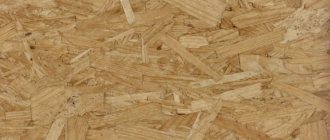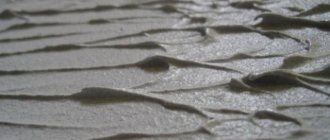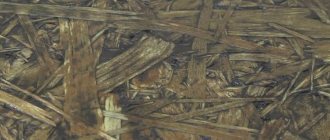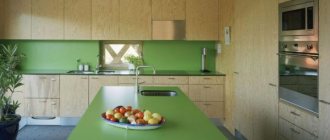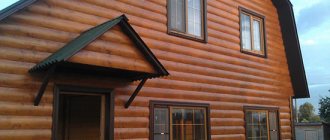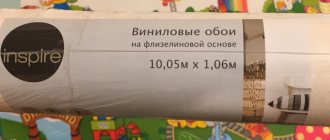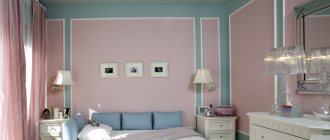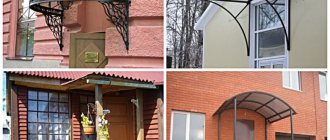Home » Building a house » Building materials
Annie Cooper 04/30/2020
34037 Views 1 comment
Oriented strand boards are often used for exterior decoration of building facades and interior work. Their characteristic, rough structure does not always correspond to the style of the room or the wishes of the home owner, so the surface is covered with paints and varnishes. Tips on what and how to paint OSB, and how to properly prepare the material for coating are collected in the material.
Material characteristics
Surface of particle boards
OSB (OSB) or oriented strand board is a sheet building material made from woodworking products (most often flat softwood chips) glued together in 3-4 layers.
The material is formed by hot pressing. The binding element is waterproof phenol-formaldehyde resin with the addition of synthetic wax and boric acid.
The name OSB is a transliteration of the English name OSB - oriented strand board.
The entire slab has a thickness of up to 3.8 cm and a length of up to 2.5 m. For production, chips of a strictly defined size are used: from 0.6 to 4 cm in width and 18 cm in length. The order of the layers in the sheet also matters: the inner ones are laid transversely, and the outer ones - lengthwise.
This structure gives the material the properties of a plywood sheet:
- increases rigidity
- prevents deformation during installation
- increases resistance to mechanical damage
Application of OSB panels
OSB is used as rough flooring (under laminate, carpet, linoleum) or wall material for construction:
- temporary structures
- frames
- small architectural forms
- converting an attic into a living room
The material is also used as a raw material for the production of sandwich panels, I-beams, as a flooring for bitumen shingles on roofs and load-bearing structures of panel formwork.
OSB competes with bakelite and regular plywood as a structural material, and fiberboard, chipboard and plasterboard as a finishing material.
Pie wall based on oriented strand board
OSB can serve as a facing and structural material for a summer house. In the latter case, the walls need to be additionally finished from the outside. However, care should be taken to cover the OSB outdoors with moisture impregnation .
The design is typical of a frame structure.
Frame – wooden or metal. The first one is more common. Constructed from wooden beams or double boards. The frame is attached to the foundation with anchors between the posts and the lintels are connected with bolts.
The filling consists of several layers. The most suitable option is ready-made sandwich panels. They are a slab of two layers of plywood, OSB, MDF and insulation inside. However, ready-made panels are quite expensive. You can solve the same problem step by step:
- fix OSB sheets on the inside;
- install insulation in the cavities between the racks or foam this space with polyurethane foam;
- sheathed on the outside with OSB.
Valera
The voice of the construction guru
Ask a Question
Waterproofing is laid between the inner wall and the insulation. A vapor barrier is placed between the outer layer of OSB and the heat insulator. This will protect against moisture getting inside.
Advantages and disadvantages
Pressed chip sheets
Oriented strand boards are superior to other building materials made from wood products in some performance characteristics:
PROS:
- Show higher fire resistance than fiberboard, chipboard, non-flammability
- They do not have defects in the material structure (delaminations, air voids, knots) unlike solid wood
- Less time-consuming compared to other types of finishing
- Provide high heat and sound insulation
- Cost less than other wood chip materials
- Externally they differ little from wood
- Not affected by wood-boring insects
- Easy to process (drill, cut, glue and paint)
- Lighter than cement bonded particle boards/
MINUSES:
- However, OSB does not provide vapor permeability.
- When heated, it can release harmful substances (due to the phenolic-formaldehyde resin in the composition).
- When used in interior decoration, sheets must be painted or covered with other decorative material.
How to prepare and how to paint OSB?
The main difficulty with painting Oriented Strand Board sheets, especially grades 3 and 4, is their high moisture resistance. It is difficult to find a suitable composition that would demonstrate decent adhesion, so the slab should first be sanded with sandpaper to roughen the surface. Don't forget to putty the joints of the sheets using wood putties. Some people prefer to make homemade mixtures using sawdust , gelatin and casein.
Step No. 1: preparatory work technology
In order to increase adhesion, moisture-resistant sheets on the floor or walls should be treated with acrylic primer. Before painting OSB indoors with non-water-based paints, the boards are primed with drying oil or polyurethane varnish. Primers based on synthetic resins have proven themselves to be excellent.
To obtain a perfectly flat surface, craftsmen often putty the entire surface to be treated. To prepare a moisture-resistant slab from the outside, you need compounds that are used to prime the surface before applying textured and mosaic plasters.
The technique for preparing panels on the outside of a building is practically no different from interior work. Additionally, it is recommended to treat them with antiseptic compounds and fire retardants. It doesn’t hurt to take into account the fact that the surface quality of each manufacturer differs significantly.
Step No. 2: how to paint wood board
In practice, the choice of paint depends on the type of particle board. In this regard, OSB1 and OSB2 are universal - they can be treated with both water-dispersion compositions and PVA- or acrylic-based paints. It is important to consider that although these sheets have good hiding power, due to their large porosity, the cost overrun can reach up to 50% compared to plywood or wood.
Among professional builders, there are certain rules when processing particle boards with paints and varnishes:
- The paint must be made on a polymer base; an emulsion based on an aqueous solution is not suitable for finishing work.
- Compositions based on acrylates will help make the surface convenient for subsequent cleaning and washing.
- To provide additional protection from moisture, you need to use materials containing alkyd, latex and polyurethane components.
Homeowners who decide to properly paint OSB indoors should take into account the specifics of the work. First of all, it lies in the particularly pronounced texture of the material. The paint will spread over the body of the wood chips, so 2-3 layers of paint will be required for a good coating. For those interested in decorating slabs, this fact will be to their advantage - several layers of color will contribute to the implementation of original visual effects.
Tinting and multi-color painting are generally acceptable only for sheets with pronounced moisture absorption. As for moisture-resistant specimens, in cases where it is not planned to lay linoleum with insulation, then enamels based on chemical solvents should be used:
- Alkyd.
- Oily.
- Polyurethane.
Types of slabs
Laminated Chip Board
There are 4 types of slabs depending on their resistance to moisture and mechanical stress.
| View | Characteristic | Application area |
| OSB-1 | Low resistance to moisture, shock, deformation | Manufacturing of furniture, used as packaging material, upholstery |
| OSB-2 | High strength but unable to withstand moisture | For the manufacture of load-bearing structures, floors, only in dry rooms |
| OSB-3 | High resistance to damage and moisture | For the production of load-bearing beams and structures in any premises |
| OSB-4 | The highest levels of moisture resistance and strength | Can be used for any premises and purposes |
For finishing, the preferred choice is oriented strand sheets of types 2 and 3.
Depending on the outer covering, sheet material can be:
- Varnished
- Laminated
- tongue and groove
The elements are distinguished according to the finishing method:
- with straight edges
- milled (to simplify installation) on both sides
- milled on four sides
Briefly about the material
Before painting the OSB board inside the house, it is important to consider that this material is available in four types. Each of them has its own properties that determine its scope:
- OSB1 - low-density panels without water-repellent treatment, mainly suitable for interior wall decoration, except in rooms with high humidity.
- OSB2 - have a little more strength than the first type, but this board also needs to be protected from moisture by painting.
- OSB3 is the most common panel with high strength and moisture resistance. However, with prolonged contact with moisture, the sheet begins to deform, so the panel outside the building will have to be treated with at least a special impregnation.
- OSB4 is a heavy-duty material that can withstand high humidity environments. But there is also a minus - the high price.
Manufacturers and prices
Finishing building materials
The most widely used chipboards on the market are those produced in Germany, Romania, Canada and Russia. The main brands with prices per 1 sheet are presented in the table:
| Brand name | Manufacturer country | Price for 1 sheet |
| Glunz | Germany | from 1200 rub. |
| Arbek | Canada | from 800 rub. |
| Norbord | Canada | from 1000 rub. |
| Egger | Romania | from 1000 rub. |
| Talion | Russia | from 500 rub. |
| Kronospan | Austria | from 550 rub. |
| Kalevala | Russia | from 600 rub. |
German sheets from Glünz are considered the highest quality (but also the most expensive); Canadian products have proven themselves well: Arbeck and Norbord. Among Russian-made building materials, OSB brands Kalevala and Talion are popular.
Junction of slabs
The most difficult thing in decorative finishing of OSB is high-quality processing of board joints. If general puttying of the plane is not planned, the seams will inevitably be visible: even if they are reinforced with carbon fiber on synthetic mastic and puttied, the difference in texture will still be noticeable.
That is why it is customary to cover the ends with planks, masking the joints. This, however, may not be entirely appropriate if the order of sewing the sheets is not thought out in advance. Be also prepared that in order to avoid the formation of a large number of disordered joints, the consumption of slabs will have to be increased by 15–20%.
The veining parts are usually attached after painting the main surface. Overlay strips stand out against the general background; they are often painted separately in colors that contrast with the rest of the surface. As overlays for the seams, you can use either wooden strips sewn with rough nails without heads, or foam “stucco” or flat moldings fixed with plastic silicate glue.
Preparing for painting
Painting sheets of shavings
Before you begin to apply the coloring product to the material indoors, it is prepared. The adhesion of the paint and the durability of the structure depend on the quality of the preparation.
Prepare the already assembled elements in the following sequence:
- Sanding with sandpaper or a sanding machine to eliminate unevenness and mask the recognizable texture of OSB. OSB-3 and OSB-4 sheets are especially carefully sanded, where the wax (varnish) protective coating must be removed. By skipping this step, there is a risk of chips and large chips peeling off
- Blowing wood dust from seams after sanding
- Leveling in places of fastening with self-tapping screws using putty mixtures based on glue and oil, “liquid nails”
- Cleaning dried putty with fine sandpaper to obtain a smooth surface
- Treatment with specialized emulsions that give the material additional resistance to moisture, combustion, fungi, and mold
- Primer with a mixture of alkyd varnish with water or white spirit (in a ratio of 1 to 10). An adhesive primer is also suitable, which will not allow the essential oils in the structure of the slab to bleed through the light pigment. If OSB-3 and OSB-4 are primed, then choose compositions for applying decorative plaster or mosaic
- The perimeter of each element is painted with a brush in 3 layers, the internal space is worked with a roller in 1 layer in one direction.
- Allow the paint to dry completely and apply a second coat.
If the material is coated with water-dispersion compounds, then only 1 layer is placed over the entire surface of the slab - this way the slab will swell evenly.
Preparatory work
Before painting OSB needs to be prepared. This is necessary to ensure good placement of paintwork materials and keep them on the surface.
If you intend to use OSB for cladding wall and ceiling surfaces, it is best to prepare the slabs before installing them on the sheathing.
First of all, sand the entire surface using a hand sander. It should have a sandpaper attachment attached to it. After removing the outer protective layer, the paint will easily get inside the material.
Once sanding is complete, mask off the seams and screw heads. You can use a special putty with increased elasticity, a sealing agent or a special tape. If the joints and holes from the screws need to be hidden entirely, while maintaining the natural color, then sawdust should be added to the putty - they will remain after cutting the sheets.
In this case, you need to ensure that the gaps are carefully filled without going beyond their boundaries. If necessary, after the putty has hardened, you can clean it with a grinding device with a sandpaper attachment.
How to choose a coloring composition
Choosing paint for wood board
To choose a paint for coating sheet particle material, it is recommended to pay attention to the following properties:
- protection from ultraviolet radiation, negative effects of the atmosphere (rain, snow accumulation), fire, rot, mold
- the presence of additives with fire-retardant and adhesion-increasing characteristics
- surface adhesion parameters
- number of layers (to calculate consumption per 1 m2)
It is also worth considering the age of the boards (the older the OSB, the worse it adheres to the surface) and their condition (before painting, the surface is cleaned of dirt, layers of old paint, and treated with antiseptics).
Composite building materials come in different types:
- Chipboard - particle boards;
- Fiberboards of different densities - fiberboard and MDF;
- WPC - wood-polymer materials;
OSB board is a layered material in which in each layer chips and shavings are laid in a certain direction.
OSB boards are characterized by special resistance to bending deformation and excellent manufacturability: ease of processing and the ability to hold fastening structures well.
The material is available with varying degrees of water resistance:
- OSB-1 and OSB-2 are not particularly water resistant;
- OSB-3 is moisture resistant, like OSB-4.
In order to improve performance and decorative qualities, composite wooden materials are coated with various varnishes and paints.
Indoor painting methods
Particle boards in interior decoration
OSB is coated with paints and varnishes to:
- Additionally protect the material from moisture and reduce the risk of fire
- Disguise the texture of slabs during interior decoration and add decorativeness to them
- Save on cladding with plasterboard or MDF panels
Experts do not recommend covering building materials with water-dispersed acrylic compounds in several layers for exterior work - the slab may swell.
OSB wall panels
For interior work, particle boards cover:
- Oil paint - it has high viscosity and is not absorbed into the material. Provides a reliable, durable coating, but takes quite a long time to dry
- Alkyd paint or enamel. Penetrates deeply into the structure of the chips, so there is no need to varnish the material on top
- Stain. With this type of painting, the natural texture of the slab remains visible. The top of the building material is coated with polyurethane or vinyl varnish to secure it. The desired tone can be obtained by diluting the composition with water, acetone or solvent
- Glazing azure. Transparent thin paint allows the chips to retain their structure and only slightly shades the color
- Transparent varnish or impregnation to preserve the natural texture of the slabs
Using OSB for interior decoration of a house
When repairing or rebuilding frame houses, OSB (oriented strand board) or OSB (the same thing, only transliterated from English) boards are increasingly being used. This is a relatively new building material that is gaining popularity.
Using OSB boards it is quite easy to cover large areas with a base. This material is smooth, light and durable. Also, its installation does not require a lot of time and money. But after installing OSB boards, many people wonder what to cover the boards with in order to preserve their performance properties and pleasant appearance. This article contains answers to all your questions regarding the finishing of OSB boards.
Application of OSB boards
The popularity of OSB boards can be explained by the fairly high uniqueness of this material. It is used in various types of work, for example, in construction, interior decoration of bodies, manufacturing of containers and furniture, etc. But problems with surface treatment most often arise precisely in connection with these types of work:
- installation of internal partitions and coverings;
- installation of floors;
- cladding of frame houses.
Finishing work of OSB boards when installing floors
To install the surface for the final finishing of floors, OSB-3 boards are most often used. Such boards are highly durable and quite moisture resistant. These characteristics make this material quite reliable as a base for floors. OSB-3 slabs are laid both on wooden logs and on a concrete screed, which directly cover the ground.
On top of OSB boards can be covered with various types of coatings, depending on the type of flooring:
- Varnish coating. The varnish is applied to the OSB board in several layers on a carefully leveled and degreased surface. Depending on the requirements, leveling the slabs before varnishing can be done with a grinding machine, iron brush or sandpaper. After the surface is sanded, a primer is applied to it. A board treated with OSB varnish is a smooth surface without any irregularities.
- Linoleum or carpet. Before covering the slab with carpet or linoleum, make sure that you have removed all uneven surfaces, especially at the joints of the slabs. Such moments at the joints of the plates are treated with silicone sealant and thoroughly cleaned. The most ideal surface for rolled materials can be achieved by using the thinnest slabs.
- Tile. When installing tiles on an OSB surface, the most important thing is the correct selection of adhesive compositions for fastening the inlet to the wooden surface.
- Laminate. In order to successfully cover the OSB laminate coating, you need to take care of the correct installation of the slabs themselves. This will ensure the formation of a flat surface, which is ideal for installing laminate flooring.
OSB boards for finishing internal partitions
In the production of OSB boards, various binding materials are used: from essential oils to dyes and resins. When subsequently used in construction, it is very important to first apply a primer to the OSB boards to avoid the bleed through of these binders directly onto the finishing materials. In some cases, wax or paraffin is added to the binding resins. This makes the surface of the slabs smoother and even sliding. When working with such OSB boards, it is necessary to use a primer paint that contains quartz sand, thanks to which other coating layers are safely held on the surface of the boards.
How to paint the panels outside
Painting slabs outside
For external finishing work - finishing the facade, installing partitions and floors - oriented strand boards are coated with impregnations, varnishes and paints:
- alkyd
- oil
- water-based
- acrylic
- latex
When choosing a material for painting, it is better to choose compositions that contain special additives that protect the slabs from exposure to UV radiation.
The coating must also be vapor permeable, otherwise mold will form on the slabs. An impermeable coating can cause warping of sheet building materials.
Alkyd paint
Alkyd paint
Alkyd paint Its composition includes plant resins, film formers (glyphthalic or pentaphthalic), pigments, purified kerosene, fillers and antiseptics. After coating and drying, a film remains on the surface of the material, which provides additional strength to the OSB.
Dries quickly, is non-toxic, creates a waterproof layer, protects against temperature changes. However, it has a pungent odor and is prone to fire.
If such a composition is applied to the slab before it dries completely, bubbles and peeling will form on the surface. This coating significantly reduces finishing costs, because the alkyd composition eliminates finishing impregnation with varnish.
Water-based mixture
Water-based paint
Water-based mixture The composition of the two-phase mixture includes water and acrylic, fillers, film formers, pigments and a number of functional additives. After drying, the water evaporates, and the polymer layer gives the slab improved performance characteristics.
In addition to such advantages of paint as quick drying, non-toxicity and lack of a strong odor, the advantages include:
- low price
- variety of colors
- high resistance to fire and moisture
- ease of application
- service life up to 10 years and above
External work is carried out at a temperature not lower than +5. In the cold the composition becomes unusable.
For finishing, water-dispersion relief paint with the addition of marble dust or fine chips is also used. Its cost is higher than that of traditional water-based paint, but due to the relief it produces a beautiful decorative look.
Latex composition
Latex composition
Latex composition A type of water-based paint, but instead of acrylic, the binder is a latex additive (based on vinyl, polyvinyl, silicone). The composition is elastic, viscous and durable, giving the surface characteristics of resistance to moisture, aggressive chemicals, UV radiation and temperature changes.
The paint is non-toxic and has no unpleasant odor. Using latex, you can get both a smooth and textured coating.
Acrylic based coating
Acrylic copolymer paints
Acrylic-based coating This raw material covers unevenness of the structure well and gives a uniform tone. It consists of polymers, water and dye, and after drying it leaves a durable film on the surface of the material. It can be matte or glossy; there are many colors in the assortment that do not require additional tinting.
The acrylic composition does not spread, does not fade, dries quickly, has the ability to allow steam to pass through, but is resistant to moisture. It is often used for interior work because it is non-toxic and does not emit harmful substances into the atmosphere when heated.
Oil paint
Oil paints
Oil paint Raw materials using drying oil are rarely used due to their high toxicity and long drying time.
The oil composition leaves a lot of streaks and unevenness, while the coating does not last long, quickly crumbling and peeling off from the surface.
What paint compositions are used for OSB boards
The following paints can be used for OSB coating:
- Acrylic. They are made from polyacrylate and copolymer components that serve to form a film.
- Polyurethane. They form a decorative protective layer on OSB and are used in construction and finishing.
- Latex. Elastic paints that are resistant to detergents.
- Alkyd. They are made on the basis of alkyd resins and form a high-strength film.
- Oily. They have a viscous consistency, which is why they form a thick layer on the slabs.
Variety of paints and varnishes suitable for OSB
There are paints designed specifically for painting OSB. They have the following features:
- creating effective protection of OSB from humidity and ultraviolet radiation;
- good adhesion to the OSB surface;
- elastic, vapor-permeable compounds;
How to make a plasterboard partition with your own hands
- a high-density paint layer prevents the natural color of the slabs from showing through;
- Available in a basic white color, they can acquire the required shade after tinting;
- environmentally friendly, produced on a water base using polymer acrylic, mineral fillers, and antiseptics.
Criteria for choosing paint for interior work
When choosing paints and varnishes for painting OSB boards indoors, you need to take into account the following factors:
- type of wood chips and type of binding components used in the manufacture of OSB;
- method of decoration - you need to determine whether you want to preserve the structure of the slab surface or whether you want to make it smooth;
- area of use (floor or wall surfaces);
- characteristics of the room in which the work will be carried out.
Fire protection
Soppka paint and varnish material
In addition to making the slabs decorative, painting can also be aimed at improving the performance characteristics of OSB. When ignited, particle boards emit caustic phenolic smoke, which is dangerous to humans, so it is important to cover the material with fire-retardant solutions.
Soppka paint is produced specifically to increase the resistance of particle boards to fire. The composition also prevents the development of mold in poorly ventilated areas.
The paint is much more viscous and thick than conventional antiseptics, and creates a protective transparent film on the surface of the material. The mixture is evenly absorbed into the OSB, despite the presence of resins in it, and is not washed out by rain over time.
Non-specialized but high-quality façade glaze Valtti Color Satin from the manufacturer Tikkuril is also suitable for fire bioprotection. It has high hiding power, does not fade in the sun and prevents wood from rotting.
What is OSB
The material is pressed wood shavings of various species . To create osb boards, coniferous wood is crushed into chips or shavings.
After this, the material is sent to special equipment, where it is molded, laid out in 3 layers.
The name “oriented” for such a material is explained by the fact that each layer is located in a certain direction in the slab.
The outer layers of the slab are laid longitudinally, the layers located inside are laid transversely. After laying out the wood material, it is sent under the press.
The gluing process is carried out using resins , to which various wax masses are added. The latter substances are necessary for the material to acquire moisture resistance properties.
The best paints for OSB
Toplazur
Paint and varnish materials that are best suited for painting OSB boards with their performance characteristics:
- Cetol Filter 7 Plus from Sikkens is a transparent paint for exterior use based on alkyd resins. The composition includes inhibitors and additives that enhance the moisture resistance of the material. Drying at 20 degrees Celsius and 65% humidity occurs in 15–16 hours
- Toplazur from Belinka is a thick-layer coating with natural wax in its composition. Suitable for both indoor and outdoor use. Dries completely within 10–12 hours after application. When updating, you only need to sand the surface from dirt and dust, and then cover the old layer of glaze with a new one
- Drevolak is a water-based protective acrylic varnish. Elastic, antiseptic and moisture-resistant, imparts dirt-repellent properties. To achieve the desired consistency and viscosity, the composition is diluted with water.
- Oil paint MA-5 from Lakra is a coating based on linseed oil. Dries completely in 24 hours, consumption for a single-layer coating is 1 liter per 10 m2. Characterized by high abrasion resistance, high adhesion
- Facade silicone paint from Southern Accent LLC is a water-dispersion paint that combines the performance characteristics of acrylic and silicate coatings. Reduces the effects of mold, mildew, UV radiation and moisture on particle boards
- Facade latex Element F-8 is a coating based on acrylic copolymers. Weatherproof, consumption is 1 l per 8 m2
Painting OSB boards outdoors
Below is an algorithm for painting OSB walls outdoors:
- Sand the surface first. To do this, you need to use a sanding machine with a sandpaper attachment, the grit of which is P180. Sanding must be done without strong pressure, because only the protective layer needs to be removed from OSB.
- Due to the fact that paraffin or wax with resins is used in the production of boards, the surface of the OSB must be covered with a barrier primer. It will ensure the delay of emerging resins and paraffin. The application of paint and varnish is carried out using a spray gun. The layer dries in 1.5 hours.
- Now you need to apply a pigment primer, which will serve as the basis for creating a range of finish colors. It is best to use a light-colored polyurethane-based primer.
- After the paint has completely dried, it needs to be sanded again. It is necessary to use sandpaper with grit P320. After this, thoroughly clean the surface from dust using a vacuum cleaner.
- To create a shine effect, you can apply a composition with a pearlescent effect to the walls. A patina is sprayed on top of it, giving the effect of “noble aging”.
- 5-7 minutes after applying the patina, you need to remove its excess with sandpaper with grit P320.
How to insulate a roof yourself: choosing insulation, work procedure
- Now you need to spray tinted acrylic-based varnish mixed with stain onto the OSB. Instead of stain, you can use another paint and varnish product. The main thing is to remember that the composition of all products used for coloring should be well combined.
- As the varnish dries, the shade may change slightly, but its matte appearance will increase. This factor must be taken into account when choosing the shade of stain or paint.
- The finishing coat should be matte, glossy or soft touch. The latter is a matte coating similar to rubber and has high elasticity.
Painting nuances
Wide brush
To apply each coating, it is better to use a separate tool suitable for the characteristics of viscosity, relief and absorbency.
You can apply coloring compounds using:
- roller
- wide brush
- spray gun
Recommended combinations of paint and tools are shown in the table.
| Paint type | The better to apply |
| Water-based | Roller with pile from 1.5 cm and above |
| Alkyd | Felt roller or fine-pore foam tool |
| Relief water-dispersion | Hair roller |
| Latex | Wide flat synthetic bristle brush |
| Embossed | Spatula with blade width 500 mm |
Tips for the dyeing process:
- When using alkyd paint, the roller is first dipped into the solution and then rolled out on a horizontal surface so that the mixture is evenly distributed.
- The recommended path of the roller along the wall is in the shape of the letter W: a vertical strip from top to bottom, two strips at an angle of 20 degrees and again a vertical strip from bottom to top.
- When painting with silicone paint, the primer should also be silicone-based for better adhesion
- Relief paint is applied with a spatula, but distributed over the surface with a roller. The thickness of the paint layer and the nature of the relief depend on the forces applied to press the roller.
- The edges of the building material absorb more paint than the front surface, so they need to be covered very carefully
- Structural elements made of OSB are painted at a humidity of no more than 60%
- When using transparent paints, it is better to choose those that contain inhibitors
- It is preferable to apply 2-3 thin layers of paint rather than 1 thick one.
Rotting and fungus on the stove
In Russia, there are diametrically opposed opinions and technologies for the construction and finishing of frame houses. All this is because the active development of frame construction in Russia began a little over 10 years ago.
What can result from improper installation of a ventilated façade, such as vinyl siding?
Despite the fact that OSB has some degree of moisture resistance due to the use of synthetic resins, it quickly loses its strength and turns into rotten dust. Which can ultimately lead to moisture getting inside the wall and the appearance of mold not only on the OSB itself, but also on the insulation and on the frame.
Of course, this problem can hypothetically be avoided by installing a counter-lattice on top of the OSB covering. But even such a solution does not guarantee that moisture from evaporation will not accumulate under the siding or imitation timber during periods of changing temperature conditions.
Condensation can also accumulate if there is a counter-lattice in those places where communications are laid or heating is installed. This increases the formation of moisture on the OSB board, thereby further exposing it to the risk of infection by fungus and mold.
Of course, many owners have not seen what is happening under their siding for many years, but now you can often find complaints about freezing of walls in places where holes have appeared in the external OSB sheathing due to rotting processes.
OSB is a real piece of wood, and after the binder resins leave it, the chips peel off - the rotting processes intensify exponentially. This can be observed in many houses built more than 5-7 years ago.
Methods for decorating slabs
Flexible stone cladding
In addition to simple painting with a single-color color, you can use the following methods for decorating oriented strand sheets:
- Coloring with an artificial aging effect. They use acrylic varnish, which is coated with a patina using an airbrush and then sanded.
- Using primer paint. Looks decorative on the facades of frame buildings, applied using a fur roller
- Application of liquid wallpaper. Reduces the emission class of the slab and extends the life of the finish
- Covering with a layer of decorative plaster. With its help you can create relief, patterns and designs on the surface of the slab
- Creating bas-reliefs using polyurethane foam or putty
- Flexible stone cladding
Each owner should decide which paint or varnish to coat OSB boards based on the nature of the work (internal or external) and the conditions of use. When choosing a paint and varnish material, you should pay attention to its composition, performance characteristics and consumption rates per 1 m2. It is also important to consider the structure of the particle board and environmental factors.
Experts talk about different methods of decorative finishing of oriented strand boards in the video:
Different methods of decorative coating of OSB panels
How and how to paint OSB: choosing reliable paint and coating method (Photo & Video) + Reviews
Users share their own experience of painting and long-term operation of painted OSB in the video:
Painting OSB boards inside the house
Let's look at the procedure for painting the floors inside the house:
- First of all, make a sketch of the future floor design. It is recommended to do it in 2 versions: graphic and color. The sketch will help you understand how the finished coating will look.
- Completely paint the OSB with base color paint. The base color should be the lightest tone of the color you selected. To apply paintwork, use a spray gun. This will allow the paint to get into all the recesses of the surface and ensure that the relief features are preserved.
- To emphasize the relief depth, you can lightly clean the surface with a grinding device.
- Now you need to divide the entire painted surface into fragments that have the shape of stones or other objects. The marking is carried out with a reference to the created sketch, and first a regular pencil is used.
- Each part of the coating must be painted with paints and varnishes of different tones, which must be prepared in advance.
- After this, each surface segment is cleaned. At this stage, it is not necessary to treat the entire surface - you can clean the floor from one or two sides of the stone to ensure a three-dimensional effect.
- Now you need to draw the contours of each of the stones.
- After drying, the surface is treated with varnish. Its base must be selected taking into account the type of paint.
Features of paint selection
The scope of OSB is wide - from use as a structural material to interior decoration and room decoration. The conditions in which OSB boards are used must be taken into account when choosing paint.
Indoors
The requirements for material used inside heated premises are less stringent, and the use of OSB-2 and higher grade boards is allowed. It is not very difficult to answer the question of how to paint an OSB board inside a house. All types of paint coatings considered are suitable for this.
Acceptable options for finishing OSB flooring would be:
- Oil or alkyd paints.
- Transparent or translucent water-based varnishes.
- Polyurethane epoxy resin.
The originality of the solution for treating OSB sheets laid on the floor with varnish lies in preserving the natural pattern of their structure.
The use of self-leveling epoxy composition with various shades or inclusions such as reflective, iridescent particles, textile fibers makes it possible to create modern decorative floors from OSB boards.
Decorative OSB flooring
It is preferable to paint the walls of children's rooms and bedrooms with environmentally friendly acrylic paints. Many of them are water resistant and allow for regular wet cleaning.
For external structures
Frame house construction from OSB boards is characterized not only by the speed of construction, but also by the affordable prices of materials. Coloring makes this technology even cheaper, without sacrificing quality, and serves important purposes:
- protection of OSB from aggressive environmental influences;
- maintaining the working properties of the material.
- decoration.
The planned design determines the choice of composition for painting OSB:
Preserve the natural texture of facade slabs:
- Alkyd transparent wood paint for exterior use with an ultraviolet filter - creates an original light-and-shadow play of reflections in the sun.
- Colorless varnishes, impregnations and azures give the walls of the house a stylish shade and gloss.
Before painting the OSB board on the facade of the house with transparent compounds, it can be tinted, emphasizing the chip texture. For this, stains and patinas are used. A variety of shades is achieved by diluting these decorative compositions with water or acetone.
To paint the OSB of external building structures in a certain color and completely hide the texture of the chips, covering enamels and water-based paints are used:
- Alkyd facade paint - forms a polymer film, creating protection from moisture and sunlight, resistant to fading and temperature changes.
- Latex facade paints are undemanding in terms of coating quality, which is important for OSB, have good covering ability and can withstand a large number of freeze-thaw cycles.
- Acrylic paints are resistant to moisture and temperature changes, vapor-tight, and inexpensive, which is essential for large volumes of facade work.
- Silicone paints - meet all the requirements for compositions for painting facades and adhere well to previously painted surfaces. The main disadvantage is the relatively high price, which makes them less popular for painting exterior structures.
When deciding how to paint an OSB board on a façade while preserving its original attractive appearance for a long time, you should be careful when choosing oil compositions. These paints are inexpensive, economical in consumption, have good adhesion, but are not resistant to precipitation, humidity and solar ultraviolet radiation.
Fire protection of OSB boards
The wooden base of OSB makes them a fire hazard, and the presence of resins and polymers in the structure of the material during combustion makes the smoke deadly due to the release of toxic substances, including hydrocyanic acid.
Therefore, fire protection of slabs comes to the fore, regardless of where they are used and in what capacity - rough or finishing material.
According to manufacturers, many paints and varnishes contain fire retardant inclusions. But to increase the fire resistance of the slabs, it is recommended to first carry out a fire retardant treatment before comprehensively covering them with paints and varnishes.
Fire retardant treatment
Following these tips will help you wisely choose the option of coating a popular construction material - OSB - in order to give it beauty and durability.
But it must be remembered that before painting the OSB board outside the house or inside the premises, preparatory work must be carried out with high quality, the main ones being sanding, sealing seams, and priming. This will save money and labor invested in painting.
Peculiarities
The features of the varnish will depend on where you will use the slabs themselves. External panels require coatings that are more stable in every sense and protect against the negative influences of the external environment. They must contain an ultraviolet filter that protects from the sun.
The varnish must also contain stabilizers (for example, based on alkyd resins, which create a film effect). Wherever you use varnish, it must be moisture resistant, because you are dealing with wood, and this is a very hydrophilic material.
It is important to note that to achieve a lasting effect you need to apply the varnish in several layers. Another advantage is that the varnished surface will look more aesthetically pleasing.
Any wood material has a tendency to ignite quickly. Therefore, if you have chosen this material as cladding for a building or for a room where there is a fireplace/any household appliance nearby that could potentially ignite, take care of your safety and select a product that has fire-fighting properties.
Can it be used?
Oriented strand board is offered in the form of panels; the main raw material for its production is pressed shavings of various types of wood.
Pressing takes place under the influence of pressure and high temperature; waterproof resins and paraffin are added to the composition. The latter ingredients are suspicious to many, as they are believed to be harmful.
The question of whether it is possible to use slabs as interior decoration can be answered as follows. OSB is offered in different versions, the marking indicates the amount of synthetic substances that can be released under the influence of temperature. Therefore, first you need to consider what class the panel belongs to. Some of their types are not dangerous to the environment and human life, so they can be installed indoors as decoration.
However, OSB is also in demand for external work, so it is often used outside the home. You can sheathe ceilings and walls using slabs that have certain markings, which you can learn about in more detail below. It is worth noting that OSB is also suitable for constructing partitions to zone space. The sheets are durable, but at the same time light enough for transportation and installation. The slabs can be installed either on a wooden frame or using a metal profile.
Step-by-step instruction
There are many options for painting OSB. You can use one color and make the surface completely smooth. Some people prefer to work without sanding and maintain the natural texture of the slab. The process is quite simple, and the technology is not much different from treating any other surface.
Large areas are painted using a roller. You can simply and beautifully cover the slab using multilayer technology. It will take a lot of time and patience, but the result is worth it.
Below are step-by-step instructions for painting with imitation natural stone.
- You should first make a sketch of the design, in color and graphic form. This will greatly simplify further work.
- Completely paint the slab with a primer-paint of the main color. The lightest shade is selected. It is convenient to use a spray gun for application. This way the composition will seep into all the textured recesses and will not spoil the natural relief.
- At this stage, you can use a sanding machine to highlight and emphasize the relief. However, this is not necessary.
- The entire area should be divided into elements, the shape of which corresponds to stones or some other objects. It all depends on the features of the chosen design. The markings can be made with a simple pencil, focusing on a pre-drawn diagram. Then, with a brush, you should outline the contours with paint 4-5 tones darker than the base.
- Each decorative fragment should be painted in different shades. The choice depends on the design and is strictly individual.
- Each element must be cleaned. It is not necessary to process the entire stone. You can simply rub it on 1-2 sides to enhance the volume.
- Again you should draw the contours of the stones. The same shade of paint is used as at the beginning.
- Wait until completely dry and apply varnish. The base is selected based on the type of paint.
This type of painting, which imitates other surfaces, is labor-intensive and is suitable for a creative person. However, it is not always possible to be so sophisticated. There is another way that even a beginner can easily handle. A good solution for slabs on walls, you can use only 2 colors of paint. Correctly perform the work according to this scheme.
- Apply pigment primer to the surface. It will be basic and will create an attractive coating. Typically a white polyurethane compound is used. Under normal conditions, the coating will dry in literally 3-4 hours.
- After drying, you should sand the surface again and carefully remove all dust after that. It is best to use a vacuum cleaner.
- You can use a special composition “Mother of Pearl Effect” to create a slight shine on the slab. Apply according to the manufacturer's instructions. It will take about an hour to dry.
- Using a spray gun, apply a patina, which will help to slightly age the surface. After spraying the paint, you need to wait about 10 minutes and remove the excess. For this, sandpaper type P320 is used. After this, all dust should be removed from the OSB again.
- In some cases, you can finish the work already at this stage. The plate turns out attractive and effective.
- Now the more responsible work begins. Mix colored acrylic varnish with stain and spray it onto the OSB. The latter can be replaced with another composition, paint. The varnish should be taken without shine. It will take about 1.5 hours to dry.
- As the composition dries, the color may change slightly, and the slab itself will become more matte. This should be taken into account when choosing materials.
- The finishing coating can be done in any way. Matte or glossy varnishes are used. A popular composition for wall treatment is soft-touch, which creates a matte elastic coating reminiscent of rubber.
You can create very attractive designs based on OSB. It is possible to decorate surfaces with designs and preserve the wood texture. The choice depends solely on the interior, because all elements must be in harmony with each other.
